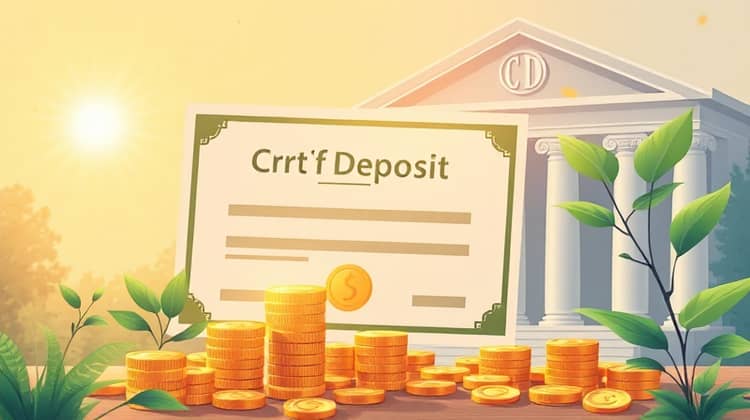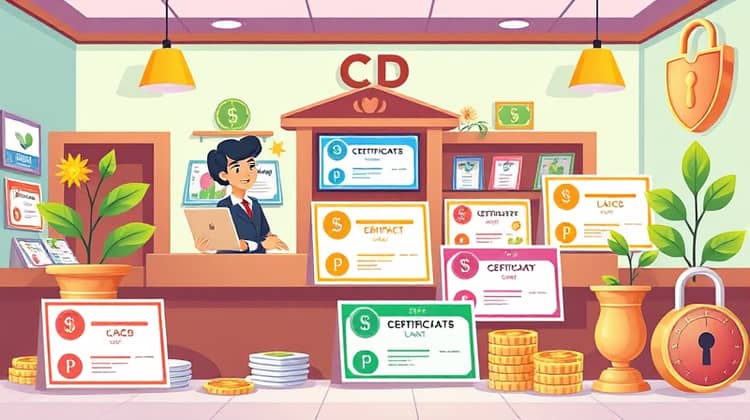Certificates of Deposit: How to Maximize Your Savings Safely

Certificates of Deposit (CDs) are a popular financial product that provide a safe and structured way to save money. They are often touted as an excellent option for individuals looking to earn interest on their savings in a risk-free manner. In this article, we will explore what a CD is, the advantages it offers over other savings options, and strategies for maximizing your returns. Whether you're saving for a specific goal or just looking to grow your wealth, understanding CDs can be a valuable part of your financial toolkit.
Investing in a CD means giving your money to a bank or credit union for a fixed period. In return, the institution pays interest on your deposit, usually at a higher rate than standard savings accounts. This investment vehicle is particularly appealing for those who want to protect their principal while earning a predictable return. Moreover, CDs are insured by the FDIC in banks and by the NCUA in credit unions, making them a safe choice for conservative investors.
As you read through this guide, you'll learn about the various types of CDs available, how to open one, and the factors to consider before investing. We'll also discuss CD laddering as a strategy to enhance your savings, the potential risks involved, and tips for selecting the best CD to meet your financial needs. Let's dive in!
What is a Certificate of Deposit (CD)?

A Certificate of Deposit (CD) is a financial product offered by banks and credit unions that allows individuals to deposit a fixed sum of money for a specified period. This term can range from a few months to several years, often with the condition that the individual cannot withdraw the funds until the term ends. In exchange for this commitment, the institution pays a higher interest rate compared to standard savings accounts.
One of the key features of a CD is its predictability. When you open a CD, the interest rate is locked in for the duration of the term, meaning you will know exactly how much your investment will earn over time. This stability makes CDs an attractive option for individuals who prioritize security and reliability in their savings strategies.
Furthermore, CDs are considered low-risk investments. Since they are insured up to $250,000 per depositor by the FDIC or the NCUA, they provide peace of mind for those concerned about losing their principal. This combination of fixed interest rates and deposit insurance contributes to their popularity as a savings vehicle, especially among conservative investors.
Overall, CDs can be an effective tool for saving toward specific financial goals, such as buying a home, funding education, or building an emergency fund. By understanding how CDs work, you can make informed decisions about incorporating them into your financial plan.
Why Choose a CD?

There are several reasons to consider choosing a Certificate of Deposit over other savings options. First and foremost, CDs typically offer higher interest rates compared to traditional savings accounts. This means that your money has the potential to grow more significantly over the term of the deposit, making it a beneficial option for long-term savers.
Additionally, the fixed interest rate of a CD provides a clear understanding of how much you will earn by the end of the term. This eliminates the uncertainty that comes with variable interest rates in savings accounts, allowing for better financial planning.
In summary, the advantages of choosing a CD include higher interest rates, fixed earnings, and safety. These features make CDs an appealing choice for those looking to increase their savings without exposing themselves to significant risks.
- Higher interest rates than traditional savings accounts
- Fixed interest rates provide predictable earnings
- Low-risk investment with FDIC/NCUA insurance
- Encourages disciplined saving habits
Ultimately, choosing a CD can lead to significant savings growth while providing the safety that many investors seek.
Types of CDs

There are several different types of Certificates of Deposit available to suit various financial needs and goals. Understanding these different options can help you select the best CD for your situation.
- Traditional CD: A standard CD with a fixed term and interest rate.
- No-Penalty CD: Allows early withdrawal without penalty after a certain period.
- Jumbo CD: Requires a larger minimum deposit but often offers higher interest rates.
- IRA CD: Designed for retirement accounts, providing tax advantages.
Each type of CD has its advantages and potential drawbacks, so it’s essential to assess your financial needs and consult with your financial institution to choose the right type.
How to Open a CD

Opening a Certificate of Deposit is a straightforward process that involves a few key steps. First, you'll need to choose a financial institution that offers CDs and compare their interest rates and terms.
- Research different banks or credit unions for the best CD rates.
- Decide on the amount of money you want to deposit and for how long.
- Complete the application process, which can often be done online.
- Fund your CD by making the required deposit.
Once your application is approved, you will receive documentation that outlines your deposit terms, and your funds will be secured for the duration of the CD term.
Factors to Consider Before Investing

Before committing to a Certificate of Deposit, it’s important to consider several factors to ensure it aligns with your financial goals.
- The interest rate offered by the CD and how it compares to other options.
- The length of the term and whether you will need access to your funds during that period.
- Any penalties for early withdrawal and how they could affect your overall earnings.
- The reputation of the financial institution you're considering.
Taking the time to consider these factors can help minimize potential risks and maximize your savings strategy.
CD Laddering: A Strategy for Maximizing Returns

CD laddering is a popular investment strategy that allows individuals to take advantage of higher interest rates while maintaining liquidity. This technique involves staggering the maturity dates of multiple CDs so that some are maturing at regular intervals, typically every few months to a year.
For example, you might invest in several CDs with different terms, such as a one-year, two-year, and three-year CD. As each CD matures, you can reinvest the principal into a new long-term CD at potentially higher rates. This approach not only maximizes your interest earnings but also gives you more frequent access to a portion of your funds.
By employing CD laddering, you can adapt to changing interest rates and avoid tying up all your savings in a single long-term investment, making it an effective strategy for savvy savers.
Risks and Downsides

While Certificates of Deposit are generally considered low-risk investments, they do come with some potential drawbacks that investors should be aware of.
- Early withdrawal penalties can significantly reduce or negate earnings.
- Inflation risk: The fixed interest rate may not keep pace with inflation.
- Limited liquidity: Your funds are inaccessible until the term ends unless you pay penalties.
- Opportunity cost: Money tied up in a CD might miss out on higher yielding investments.
Understanding these risks can help investors make more informed decisions about including CDs in their financial portfolio.
Tips for Choosing the Right CD

When selecting a Certificate of Deposit, there are several tips to keep in mind to ensure you choose one that meets your financial needs. First, it’s essential to compare interest rates from different financial institutions to find the best deal available.
Additionally, consider your financial goals, including how long you can set aside funds without needing access to them, and evaluate whether the penalties for early withdrawal align with your savings strategy.
- Look for institutions that offer competitive rates compared to the market average.
- Consider the length of the term based on your financial goals and liquidity needs.
- Check for any account fees that may reduce your overall returns.
- Review the bank’s customer service reputation for account management.
Following these tips can help you find a CD that maximizes your returns while aligning with your personal savings strategy.
Conclusion: A Safe Harbor for Your Savings

In summary, Certificates of Deposit provide a secure and effective way to save and grow your money. With higher interest rates than standard savings accounts, fixed terms, and the assurance of FDIC or NCUA insurance, they are a popular choice for those seeking relative safety in their investments.
By understanding the various types of CDs available, the benefits they offer, and employing strategies like CD laddering, you can maximize your returns on savings while minimizing risks. The key is to assess your financial goals and choose the right type of CD that fits your needs.
As part of a well-rounded portfolio, CDs can serve as a safe harbor for your savings, providing peace of mind and earning potential even in volatile economic times.






